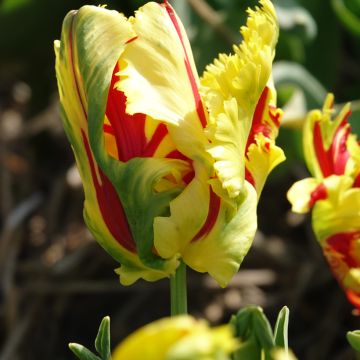

Tulipe botanique batalinii Bronze Charm
Tulipa batalinii Bronze Charm
Tulipa batalinii Bronze Charm
tulip
Package forgotten in the box! I called today and it will be sorted out." Analyse du texte traduit : - Le texte traduit est grammaticalement correct et conserve le même ton que l'original. - Aucune faute d'orthographe n'a été détectée. - La structure de la phrase est correcte et respecte le sens du texte original. - Aucune maladresse de langage ou tournure inappropriée n'a été identifiée. - Le document est correct sur le plan linguistique.
Renée R., 25/09/2018
Special offer!
Receive a €20 voucher for any order over €90 (excluding delivery costs, credit notes, and plastic-free options)!
1- Add your favorite plants to your cart.
2- Once you have reached €90, confirm your order (you can even choose the delivery date!).
3- As soon as your order is shipped, you will receive an email containing your voucher code, valid for 3 months (90 days).
Your voucher is unique and can only be used once, for any order with a minimum value of €20, excluding delivery costs.
Can be combined with other current offers, non-divisible and non-refundable.
Why not try an alternative variety in stock?
View all →This plant carries a 6 months recovery warranty
More information
We guarantee the quality of our plants for a full growing cycle, and will replace at our expense any plant that fails to recover under normal climatic and planting conditions.

Does this plant fit my garden?
Set up your Plantfit profile →
Description
The adorable little flowers of the 'Bronze Charm' Botanical Tulip are adorned with a nuanced colour: apricot, peach, and melon, with a touch of bronze in the throat. They bloom in April-May, on dwarf plants with a sturdy habit, whose shiny green ribbon-like foliage radiates with health. From its Uzbek and mountain origins, it has a clear preference for well-drained, moist soils in spring, and dry soils in summer. This bulbous plant is also long-lasting, faithfully flowering each year in the middle of the season and will naturalise over time.
Tulipa batalanii is a perennial bulb belonging to the lily family. Its origins are lost in the mountains of Central Asia, between Uzbekistan, Kazakhstan, and Tajikistan. It is related to Tulipa linifolia, of which it is a depigmented form, and to Tulipa maximowiczii which closely resembles the latter.
The 'Bronze Charm' form, commonly associated with botanical species, stands out with its apricot to light orange colour tinged with peach and orange shades. The base of the petals and the throat are touched with bronze. Each flower is slightly different and the overall effect is quite charming. This small tulip will reach 15 to 18 cm (6 to 7in) high when in bloom in April-May. It produces a flower at the top of a short, robust stem composed of a corolla of 6 shiny and iridescent petals, pointed at their tips, which close in the evening. The flowers emit a light fragrance. Its foliage is deciduous in summer and consists of 4 or 5 sword-shaped, narrow, medium green, and shiny leaves.
Botanical tulips do not degenerate over time like large-flowered tulips. They naturalise and can remain in place for several years without special maintenance and thrive in borders and rockeries. To create colourful scenes, they can be paired with various small bulbs: Crocus, Allium moly, small-flowered Daffodils, Muscari... These tulips are unrivalled in bringing the colour of spring to pots or sunny gardens.
There are various wild species, many of which are endangered. In cultivation, these are called « botanical tulips », and one of the most common is the wild tulip (Tulipa sylvestris), which often used to grow sheltered by vines and whose subspecies australis is known as the southern tulip.
Tulipa batalinii Bronze Charm in pictures


Plant habit
Flowering
Foliage
Botanical data
Tulipa
batalinii
Bronze Charm
Liliaceae
tulip
Cultivar or hybrid
Other Botanical Tulips
View all →Planting and care
Plant Tulipa batalinii 'Bronze Charm' bulbs in the autumn, from September to December, 10 cm (4in) deep and 10 cm (4in) apart, in ordinary, slightly acidic, neutral, or slightly alkaline, loose, well-prepared, and most importantly, well-draining soil. Coarse sand or gravel may need to be incorporated into the planting soil, as botanical tulips are sensitive to wet winters and summers in heavy, waterlogged soils. Never add poorly decomposed manure or compost to the planting soil, as this could cause the bulbs to rot. Tulips will grow well in moist to dry soil. Plant it in a sunny or partially shaded location in warm climates.
After flowering, their foliage becomes unsightly, so we recommend planting Heucheras, Tiarellas, Brunneras, Bleeding Hearts or Cyparissus Spurge, at the foreground of your flowerbeds. Their foliage will enhance the colours of your tulips, and elegantly hide their yellowed leaves.
Planting period
Intended location
Care
Planting & care advice
-
, onOrder confirmed
Reply from on Promesse de fleurs
Similar products
Haven't found what you were looking for?
Hardiness is the lowest winter temperature a plant can endure without suffering serious damage or even dying. However, hardiness is affected by location (a sheltered area, such as a patio), protection (winter cover) and soil type (hardiness is improved by well-drained soil).

Photo Sharing Terms & Conditions
In order to encourage gardeners to interact and share their experiences, Promesse de fleurs offers various media enabling content to be uploaded onto its Site - in particular via the ‘Photo sharing’ module.
The User agrees to refrain from:
- Posting any content that is illegal, prejudicial, insulting, racist, inciteful to hatred, revisionist, contrary to public decency, that infringes on privacy or on the privacy rights of third parties, in particular the publicity rights of persons and goods, intellectual property rights, or the right to privacy.
- Submitting content on behalf of a third party;
- Impersonate the identity of a third party and/or publish any personal information about a third party;
In general, the User undertakes to refrain from any unethical behaviour.
All Content (in particular text, comments, files, images, photos, videos, creative works, etc.), which may be subject to property or intellectual property rights, image or other private rights, shall remain the property of the User, subject to the limited rights granted by the terms of the licence granted by Promesse de fleurs as stated below. Users are at liberty to publish or not to publish such Content on the Site, notably via the ‘Photo Sharing’ facility, and accept that this Content shall be made public and freely accessible, notably on the Internet.
Users further acknowledge, undertake to have ,and guarantee that they hold all necessary rights and permissions to publish such material on the Site, in particular with regard to the legislation in force pertaining to any privacy, property, intellectual property, image, or contractual rights, or rights of any other nature. By publishing such Content on the Site, Users acknowledge accepting full liability as publishers of the Content within the meaning of the law, and grant Promesse de fleurs, free of charge, an inclusive, worldwide licence for the said Content for the entire duration of its publication, including all reproduction, representation, up/downloading, displaying, performing, transmission, and storage rights.
Users also grant permission for their name to be linked to the Content and accept that this link may not always be made available.
By engaging in posting material, Users consent to their Content becoming automatically accessible on the Internet, in particular on other sites and/or blogs and/or web pages of the Promesse de fleurs site, including in particular social pages and the Promesse de fleurs catalogue.
Users may secure the removal of entrusted content free of charge by issuing a simple request via our contact form.
The flowering period indicated on our website applies to countries and regions located in USDA zone 8 (France, the United Kingdom, Ireland, the Netherlands, etc.)
It will vary according to where you live:
- In zones 9 to 10 (Italy, Spain, Greece, etc.), flowering will occur about 2 to 4 weeks earlier.
- In zones 6 to 7 (Germany, Poland, Slovenia, and lower mountainous regions), flowering will be delayed by 2 to 3 weeks.
- In zone 5 (Central Europe, Scandinavia), blooming will be delayed by 3 to 5 weeks.
In temperate climates, pruning of spring-flowering shrubs (forsythia, spireas, etc.) should be done just after flowering.
Pruning of summer-flowering shrubs (Indian Lilac, Perovskia, etc.) can be done in winter or spring.
In cold regions as well as with frost-sensitive plants, avoid pruning too early when severe frosts may still occur.
The planting period indicated on our website applies to countries and regions located in USDA zone 8 (France, United Kingdom, Ireland, Netherlands).
It will vary according to where you live:
- In Mediterranean zones (Marseille, Madrid, Milan, etc.), autumn and winter are the best planting periods.
- In continental zones (Strasbourg, Munich, Vienna, etc.), delay planting by 2 to 3 weeks in spring and bring it forward by 2 to 4 weeks in autumn.
- In mountainous regions (the Alps, Pyrenees, Carpathians, etc.), it is best to plant in late spring (May-June) or late summer (August-September).
The harvesting period indicated on our website applies to countries and regions in USDA zone 8 (France, England, Ireland, the Netherlands).
In colder areas (Scandinavia, Poland, Austria...) fruit and vegetable harvests are likely to be delayed by 3-4 weeks.
In warmer areas (Italy, Spain, Greece, etc.), harvesting will probably take place earlier, depending on weather conditions.
The sowing periods indicated on our website apply to countries and regions within USDA Zone 8 (France, UK, Ireland, Netherlands).
In colder areas (Scandinavia, Poland, Austria...), delay any outdoor sowing by 3-4 weeks, or sow under glass.
In warmer climes (Italy, Spain, Greece, etc.), bring outdoor sowing forward by a few weeks.





















































